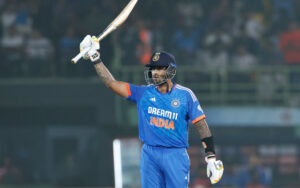
Surya Kumar Yadav yet again played a stellar hand in leading India to a win in the inaugural T20I over Australia on Thursday night, while chasing a formidable Australian total of 208. Leading the team, Surya played some breathtaking shots and, at no point, seemed in doubt about his gameplan. That’s what brings us to the question: why can Surya do it in T20 cricket when he hasn’t been able to in the 50-over format? An innings like this in the World Cup final might have meant a very different outcome.
A deep dive brings into focus two things. First, in the T20 format, Surya plays fearless cricket. He knows he is one of the best in the world and, from ball one, there is a kind of arrogance in his batting. It is not so in the 50-over format. In the World Cup final, for example, Surya seemed under pressure. He just did not want to fail, and that’s what resulted in him being circumspect and apprehensive. The freedom with which he plays T20 cricket was missing. He knows that if he gets out playing his shots in the shorter format, he won’t be criticised. The format lends itself to such expression. But as a finisher in the 50-over game, Surya seems unclear about his role. With Mohammed Shami, Jasprit Bumrah, Kuldeep Yadav and Mohammed Siraj to follow, he was unclear about whether to hit or take the innings deep. Getting out in trying to hit might invite criticism, and trying to take the game deep while not scoring at his usual pace would also invoke fan ire. He was caught between the devil and the deep sea in the 50-over format.
Secondly, we also need to question the role assigned to him. In T20 cricket, he bats at No. 3 or No. 4 and knows that if he gets out, there are others after him who can come and hit the ball. There is a certain freedom of expression that comes with the job. Not so in 50-over cricket. Batting at No. 6 with little left to come meant he could’t play his natural game. The fact that the Indian tail didn’t wag like Australia’s – that there was no one like Mitchell Starc or Pat Cummins at number 8 or 9 impacted Surya. In trying to curb his natural instincts, he went into a shell and lost focus. Not playing his natural game hurt him and, in the process, also hurt his team.
Surya has quality. Some of the shots he played on Thursday stand proof. The first flick for six over fine leg or the slash over point come effortlessly to him. And that’s where you have to ask the question: why he can’t play the same game in the 50-over format? It is all in the mind. He seems comfortable and at ease in T20 cricket, while that isn’t the case in the longer white-ball version. Such things can happen to anyone. In corporate life, we have come across multiple examples of a role not suiting a talented youngster. Churn in the media is common. Many don’t like the roles assigned to them and move on. If you like eating fish in Kolkata, for example, that doesn’t mean you will like the Fish and Chips in England. Many find it bland and smelly and never go near it. The role of the finisher in 50-over cricket, with little or no batting to come after him, hasn’t suited Surya. That’s what has created the dilemma. Should he hit or should he not? What if he gets out? How will that be looked at?
Does this then mean that his 50-over career is done with? While it doesn’t really matter right now with the next World Cup four years away in 2027, suffice to say that Surya should concentrate on the T20 format, for that’s where he has the chance of doing well and winning India a world title in six months’ time. Also, no one wants to fail and get hurt. It impacts self-confidence. Time and again, it has happened with him in the 50-over game. So maybe, Surya is meant for T20 cricket. A sprinter is not necessarily a 400-metre runner. Golds in the 100 and 200 should be considered enough. With Surya, it is time to accept this reality and move on.




